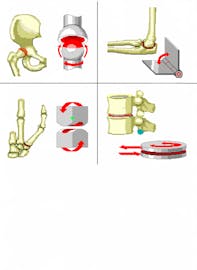Saddle Joints: Opposable Movement & Thumb Anatomy
Explore the saddle joint's anatomy & function, featuring the carpometacarpal thumb joint for gripping & tool use. Enhance your knowledge with Innerbody's educational guide.

A saddle joint is a synovial joint where one of the bones forming the joint is shaped like a saddle with the other bone resting on it like a rider on a horse. Saddle joints provide stability to the bones while providing more flexibility than a hinge or gliding joint. The bone sitting on the saddle can move in an oval shape relative to the other bone, similar to a condyloid joint.
The best example of a saddle joint in the body is the carpometacarpal joint of the thumb that is formed between the trapezium bone and the first metacarpal. In this example, the trapezium forms a rounded saddle onto which the first metacarpal sits. The carpometacarpal joint of the thumb makes the human thumb opposable by allowing it to move across the palm to contact the other four fingers of the hand. The opposable thumb is, of course, an extremely important human trait that allows our hand to firmly grip objects and make use of tools.


